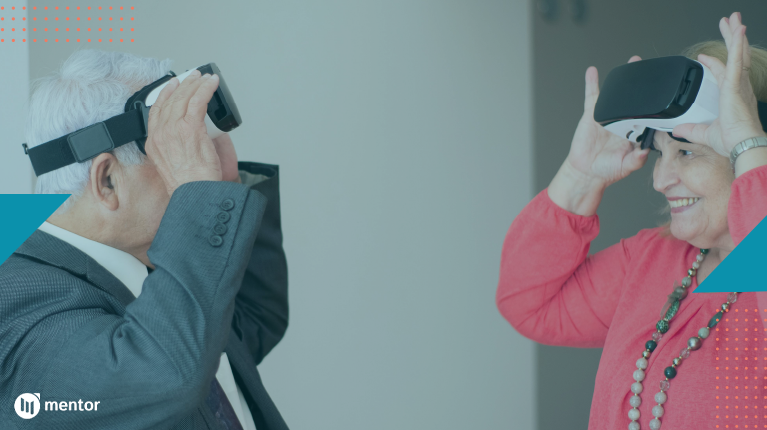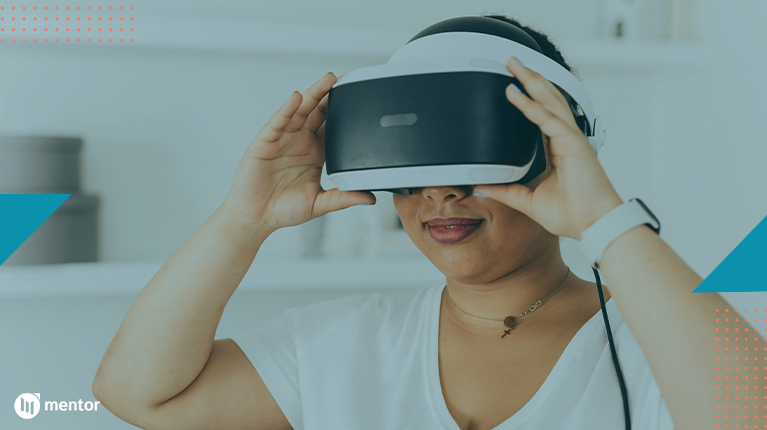Employee training has evolved exponentially through virtual reality (VR), artificial intelligence (AI) and augmented reality (AR). These new solutions have streamlined the training world, raising the bar across all industries.

Traditional methods such as classroom learning and seminars have become outdated, or certainly updated, to virtual learning platforms and webinars. So in this blog post, we’ll aim to break down this evolution and its benefits.
Understanding the use of VR, AI and AR in employee training
VR, AI and AR can all be used in unison to provide a holistic approach to employee training across the board. Artificial intelligence aids by streamlining the training process by monitoring progress, establishing key pain points, and automatically adjusting training plans to suit the trainee(s).
All of these advanced technologies are used in unison with traditional training techniques to offer an advanced twist on proven methods. For example, using VR can allow us to host virtual roleplay training sessions, set in a virtual environment which mimics the real life scenario your employee would be in. Without VR, these roleplay training sessions would still be possible, but without the level of realism which virtual reality allows for.
Another example is product demonstrations. VR and AR both allow us to provide product or service demonstrations without actually needing the product. Again, without this technology, product demonstrations would still be possible, but they would be a lot more expensive and a lot more time consuming.
Classroom training vs virtual training
Whilst classroom training has served an important role for a long time, and still has many benefits, we’re noticing increasing numbers of clients who want all the benefits of virtual training. It seems that businesses looking for employee training are often swayed by the numerous advantages of virtual training programs:
- Virtual training is much more versatile than classroom training. You can accommodate more people, you don’t need to have everybody in the same place at the same time and you won’t take as much time out of employees’ busy schedules. This also makes scalability much easier.
- Classroom training requires less specialist equipment than virtual reality training. Naturally, VR training needs a VR headset, and for any business or organisation of moderate size, you’ll probably need multiple headsets in order to consistently train all your employees.
- Both methods allow for human interaction. It’s a common misconception that virtual training eliminates any interpersonal interaction, but this is actually not the case. In fact, virtual and augmented reality training techniques usually require a trainer to be present, ensuring the process runs smoothly and correctly. On top of this, whilst some other virtual training don’t allow for actual physical interaction, they still allow for a lot of conversation, and interpersonal communication.
How is VR technology used in training?
VR and AR are components best used alongside AI, and we use these technologies to build unlimited virtual environments to provide the most realistic and beneficial training experience for trainees.
Virtual and augmented reality are both largely used for roleplay based training; virtual reality creates a completely fictional environment, which can be altered to meet the needs of your training program. Augmented reality works in a similar way, but instead it alters the world around you, changing elements of the world to suit the training program.
VR and AR can be used to provide product demonstrations too, at a much cheaper cost than actual physical product demonstrations. This is also very versatile, regardless of industry, this tech can be used to train your employees about the product or service you sell.

How AR and VR technologies are beneficial in employee training
Augmented and virtual reality technologies are beneficial in employee training because they provide an interactive way for your employees to participate in simulations and apply knowledge/learning, in a simulated and controlled environment.
No matter your industry, this technology reduces the risk factor often associated with learning on the job, whilst still providing the same beneficial learning experience to employees. Your employees will learn faster than ever, with realistic experiences that can be extrapolated to the real world, but they won’t be testing what they’ve learned on real life customers straight away, so the risk of making mistakes which cost sales or happy customers is reduced greatly.
The benefits of VR, AR and AI employee training over traditional training
VR, AR and AI powered employee training are overall much more effective and beneficial for your business than traditional training methods. They allow for more versatile, less restricted training plans which can be applied to large teams. The use of AI allows for hyper-personalised training, which targets the exact strong and weak points of every individual within your company.
These technologies are changing the game when it comes to employee training and we’ve seen success with a number of clients, so get started today.
If you want to learn more about how Mentor Group can help your business adopt a revenue-centric strategy, and transform the revenue potential of your organisation in the process, visit our Contact Us Page or reach out directly to info@mentorgroup.com









